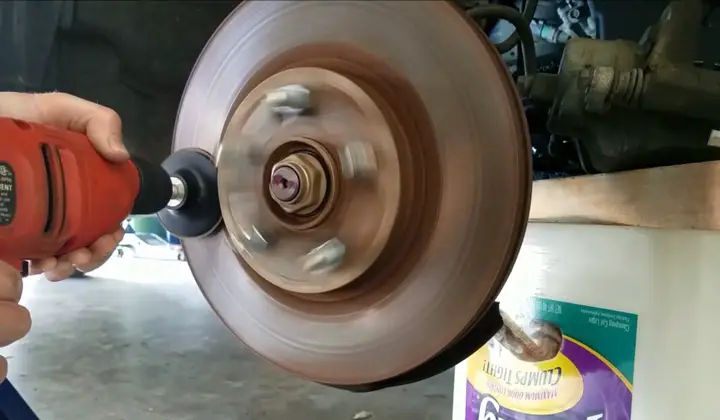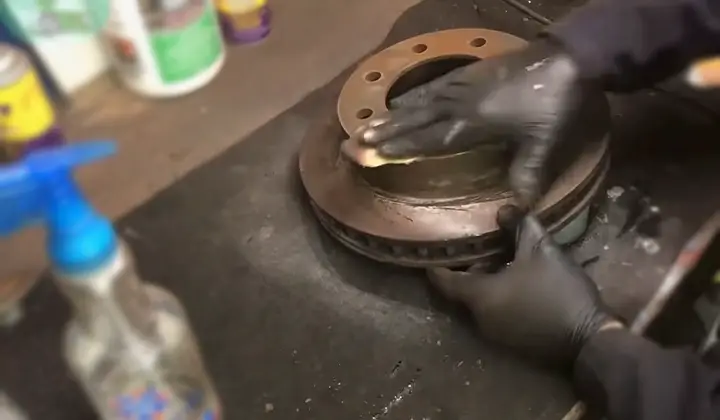Whether it is okay or not depends on what you are actually trying to do with brake rotors while sanding. Sanding makes the rotors more even so that you get a better pedal feel. It also improves the overall brake performance. And about the dos and don’ts regarding brake rotor sanding, here are some key insights.

Contents
What is Sanding on Brake Rotors?
The primary reason for resurfacing rotors is to get a thick rotor surface. By resurfacing, the calipers will grip evenly while the rotor spins around. Furthermore, uneven parts of the rotor cause inaccurate applications of brake rotors. So, resurface the rotor in such a manner so that the rotor is perfectly even.
In other words, be conscious of the minimum thickness set by the manufacturer while resurfacing. Skip the rotors that are below the manufacturer’s thickness as they might hamper the ability of calipers. And calipers may not be able to make contact with the rotor to brake successfully.
Is It Ok to Sand Brake Rotors?
As stated earlier, whether it is okay or not depends on what you are trying to achieve through sanding. If the brake pedal is vibrating because of warped rotors, hand sanding is definitely not a good option. You’ll need a trained professional to turn them on a lathe.
If you want to remove some non-rotor materials from the rotor surface, sandpaper is a good choice. For instance, if the car is sitting and the pads have stuck to the rotor and left residuum, you can turn the wheels on to free the pads.
After that, sand off the residual pad material. Doing so will make sure the rotor stays away from warping. Despite rusting the rotors poorly, sometimes you may be able to use them again by only sanding off the rotor’s surface.
How Can I Sand Brake Rotors?
Before installing the brake rotor, having necessary preparations is a must. You cannot just buy a brand-new rotor and throw it at the car. If you try to install brake pads on old brake rotors without preparation, things will only get worse. If you are not getting the maximum effectiveness out of the new brake pads, it may cause the brakes to squeal.
Most suppliers on-car lathe claim sanding after turning is unnecessary till proper feed rates and sharp lathe bits are used. The finishing should be within specification so that no problems arrive.
Sanding enhances the finish by making the outer surface of rotors smoother. It trims the sharp peaks as well as separates and flexes the metal residual on the surface. Above all, it provides 2 to 5 micro inches finishing that gives you a better pedal feel, quicker pad seating, and improves overall brake performance.
People may tell you that sanding the brake rotor is unnecessary. But while installing a brand new rotor, it is almost obvious to sand brake rotors. Rotors can be sanded in various ways.
The first method is to apply a non-directional finish with 80 to 120 grit sandpaper on a flat sanding block. While the rotor is spinning at its regular speed on the lathe, keep up a pair of sanding blocks against the brake rotor for about one minute.
On the other hand, the most common process is to use an abrasive pad on a drill. This method is not entirely risk-free because it is hard to abrade the rotor evenly. The best practice is to use a fresh sanding pad for each side of the rotor. Otherwise, metal buildup on the pad may make the surface rougher.
Always remember that you are not trying to remove any metal while sanding. Instead of removing any material on the rotor, just scratch the surface. A minute or less on each side should be enough. Be careful though. While using a sanding disc, you may see scratches.
While installing new brake pads on old rotors, sanding becomes more critical. The surface of the old rotor gets coated with the old pad material or some residual object. And if that occurs, the new friction material may come in contact with them instead of the rotor. But if you want more effectiveness, it needs to be connected with the rotor.
Can I Hand Sand Brake Rotors?

In a word, you cannot hand sand brake rotors. Therefore, do not expect satisfactory results from hand sanding. The machining of brake rotors demands high accuracy, which is almost impossible to achieve through hand sanding.
The entire rotor needs to be evenly smooth. Otherwise, the uneven rotor does not connect effectively with the brake. Even if you get the exact results, it will take ages to do the sanding by hand.
Frequently Asked Question
How much will it cost to smooth rotors?
If you take your vehicle to a repair shop, they will charge you around 150 to 200 bucks for the labor cost. Besides, there are hidden charges like taxes and all that, not to mention, you might need additional parts as well. So, expect at least $400-500 including all the expenses.
Which sandpaper should I use to sand my rotors?
Go for a hundred and twenty grit sandpaper to get the best possible outcome while sanding the rotors.
Conclusion
It turns out that you can sand your brake rotors, and it is completely okay. Yet, there are some terms and conditions. For example, hand sanding is not a wise option for beginners. And no matter what you do, you cannot scratch your rotors roughly. Anyhow, make sure you wear a dust mask since the dust is pretty toxic.
